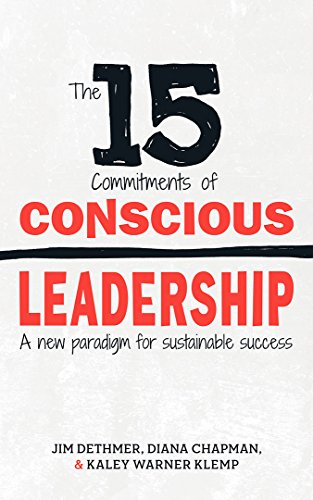The 15 Commitments of Conscious Leadership Summary

4 min read ⌚
 A New Paradigm for Sustainable Success
A New Paradigm for Sustainable Success
There are two types of leaders: conscious and unconscious. If you want to be the latter one – you don’t need this book; but, also, probably, not many of your employees like you. If you want to be the first one – then, here’s your manual.
Jim Dethmer, Diana Chapman, and Kaley Warner Klemp’s “The 15 Commitments of Conscious Leadership.”
About Jim Dethmer, Diana Chapman, Kaley Warner Klemp
 Jim Dethmer is a leadership coach and motivational speaker, the founder of Conscious Leadership Group (CLG). He has co-authored two books, the second of which is with Jim Ware, “High Performing Investment Teams.”
Jim Dethmer is a leadership coach and motivational speaker, the founder of Conscious Leadership Group (CLG). He has co-authored two books, the second of which is with Jim Ware, “High Performing Investment Teams.”
 Diana Chapman is CLG’s co-founder and a sought-after leadership advisor. She has counselled over 1000 leaders and has been a speaker at TEDx.
Diana Chapman is CLG’s co-founder and a sought-after leadership advisor. She has counselled over 1000 leaders and has been a speaker at TEDx.
 Kaley Warner Klemp is a transformational leadership advisor and YPO facilitator. In addition to co-authoring “The 15 Commitments of Conscious Leadership,” she has also written “13 Guidelines for Effective Teams.”
Kaley Warner Klemp is a transformational leadership advisor and YPO facilitator. In addition to co-authoring “The 15 Commitments of Conscious Leadership,” she has also written “13 Guidelines for Effective Teams.”
“The 15 Commitments of Conscious Leadership Summary”
So, what kind of a leader are you?
According to “The 15 Commitments of Conscious Leadership,” you can be one of two types: conscious, or unconscious.
The names speak for themselves.
Unconscious leaders are, really, just going with the flow. They employ traditional models, don’t want to learn anything new, and when the push comes to shove, everyone can be blamed or motivated through fear and threats.
Don’t rush to any conclusions just yet: this kind of leadership works! But only in the short run. While creating a hostile and unsafe atmosphere where hate and distrust prevail.
So, believe us: you don’t want to be that boss.
But if you want to be the conscious one – you’ll have to spend some time working on yourself. And we’re about to teach you the 15 basic strategies on how to become that person.
Starting with commitment #1: taking radical responsibility.
The Navy SEALs do it, football managers do it – and you should do it too. The premise is as bright and clear as the sky in July: when something goes wrong, blame no one but yourself. That’s how you earn your employees’ trust and respect.
That’s how you learn as well! Learning through curiosity is the second commitment and, obviously, it means exploring, but, even more, understanding that it’s the pioneers who make the most mistakes. But, they are also the ones who pave the way forward.
Commitment #3: feeling all feelings. Or, in other words, mastering your emotional intelligence. Don’t repress or recycle bad feelings. Analyze them; talk them out.
The fourth commitment is related: speaking candidly. If you want your employees to be open with you, do yourself a favor and be open to them as well. Listen attentively and express yourself honestly. That way – you’ll eliminate gossip, which is the fifth commitment.
The sixth commitment is practicing integrity. If you’re committed to the five commitments explained above, you’re all but doing it. The only thing missing: keeping your word. Say what you do – and do what you say.
This should generate appreciation which is commitment #7. Return the favor: appreciate your employees as well for their abilities and their uniqueness.
Speaking of uniqueness: excel in your zone of genius. This is one of the reasons leaders are respected. Don’t forget that genius is not transferable – if you’re the best in one areas, you’re not the best in all areas.
Commitment #9: living a life of play and rest. Everybody wants to have fun. Be the role model and play yourself. Work shouldn’t be boring. Don’t forget: all work and no play makes Jack a dull boy.
The tenth commitment is just as important: exploring the opposite. Accept other people’s interpretations – because, you’ll be right in, at best, only half of the cases.
The eleventh commitment is worded much more complex than it actually is: sourcing approval, control, and security. In reality, it means finding a way to be happy with what you have.
Which brings us to commitment #12: having enough of everything. Time, love, money – it’s logical that at some point you’ll get enough of each of them. So, stop endlessly chasing them.
Experiencing the world as an ally is the thirteenth commitment. Not everyone is against you. On the contrary, in fact: virtually everything and everyone can help you in some way.
And if that’s not the case – see commitment #1 – it’s your fault. Because, you need to create win for all solutions. Compromise and competition aren’t the only ways to go. There’s always a third side to every argument.
And that third side is you. Which is why being the resolution is the final, fifteenth commitment of conscious leadership.
Don’t be the problem.
Key Lessons from “The 15 Commitments of Conscious Leadership”
1. Be a Conscious Leader
2. Take Full Responsibility for Your Actions
3. Be the Resolution to All the Problems
Be a Conscious Leader
There are two types of leaders: unconscious and conscious.
Unconscious leaders don’t really need books to lead their companies. But, that’s not because they know how to lead; but because they listen to their instincts.
And, in the short run, their instincts work; but, in the long run, they make them unloved managers of an unloving environment.
Take Full Responsibility for Your Actions
The first commitment of any conscious leader: take full and radical responsibility for your actions. Which means: both your successes and your mistakes.
A word of warning: there will be many of both.
Be the Resolution to All the Problems
This is the final commitment: be the resolution. Never be the problem. There are many of the latter. Very few of the former.
By committing yourself to be the resolution, you’ll inspire resolute commitment from your subordinates. Which will make leadership a song!
Like this summary? We’d like to invite you to download our free 12 min app, for more amazing summaries and audiobooks.
“The 15 Commitments of Conscious Leadership” Quotes
At any particular time, leaders are operating from either fear or love. Share on X We often describe unconscious leaders as reactive. They react from a ‘story’ about the past or an imagined future, and their personality, ego, or mind takes over. Share on X Burned-out, stressed-out, and frazzled leaders foster organizations that experience high turnover, low employee engagement, steep healthcare costs, and dysfunctional teams. Share on X The current models of leadership require organizations to motivate their people largely with fear and extrinsic rewards. Share on X The team that sees reality the best wins. (via Jack Welch) Share on X







